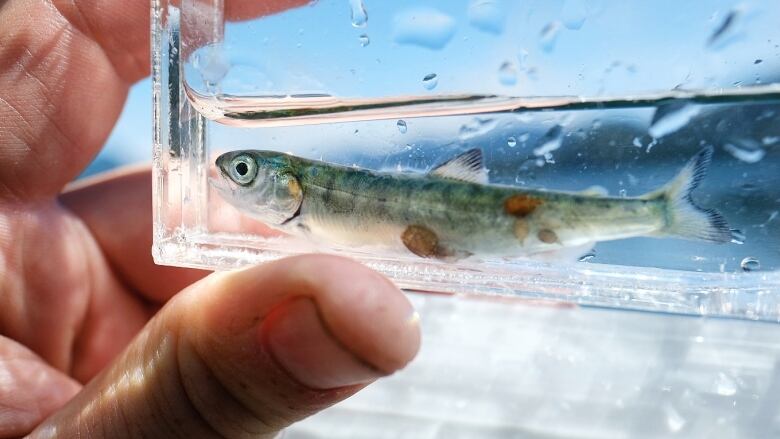Salmon farms not 'solely' to blame for growing B.C. sea lice infestations, claims DFO study
Report still notes upward trend of sea lice infestation in studied areas since 2013, however

A government study claims fish farms aren't solely to blame for the growing prevalence of sea lice among wild salmon along the B.C. coast.
The Fisheries and Oceans Canada (DFO) report, based on data provided by fish farm operators, claims that there is no "statistically significant association" between sea lice infestations among wild juvenile Chum and Pink salmon and the fish farms they migrate past along the B.C. coast.
However, the report still notes that there has been an upward trend of sea lice infestation in the studied areas, which include Clayoquot Sound and the Discovery Islands, since 2013.
It concludes that the lack of statistical significance means infestations cannot "solely be explained" by the presence of farms.
Stakeholders of B.C.'s fish farm industry have been quick to use the study to declare that farms pose no risks to wild salmon populations, while critics say the report is flawed, pointing to the growing number of infestations in B.C. waters and studies that suggest sea lice numbers often go underreported by the industry.
Parasitic sea lice occur naturally in the Pacific Ocean, but they tend to thrive in fish farms because of the high density of fish.
Sea lice don't generally harm adult fish, but when the parasites attach to the skin of young fish, they can weaken or even kill them.

Critics unconvinced
Salmon farms are required to perform monthly counts of the sea lice on their fish and make those numbers publicly available. The counts are self-reported, but fisheries officials perform occasional, pre-arranged audits to make sure the numbers are accurate.
A 2020 study found mandatory sea lice counts performed by the operators of the fish farms drop by between 15 and 50 per cent when they're not being done during an audit.
"In the face of an enormous amount of evidence, they continue to deny something as simple and as obvious as the impact of sea lice," said Alexandra Morton, a biologist, activist with Raincoast Research Society.
Morton says the conclusions reached in the latest DFO study reflects unreliable sampling data provided by farmers and consulting firms hired by them.
"If you keep your numbers straight ... you can see, they don't have lice, and then they pass the farms, and do have lice," she said.
The DFO study does reference past reports that have found that infestations on both farmed and wild salmon were correlated within 30 kilometres of farms.

Farmers association defends collection
The B.C. Salmon Farmers Association, however, contends that study confirms that the presence of farmed salmon does not appear to have a measurable impact of sea lice counts on wild salmon populations.
The group has disputed past claims that industry sea lice numbers go underreported, criticizing how data in the 2020 study was modeled.
"We don't underreport any numbers," said Brian Kingzett, the association's executive director. "Every salmon producer retains highly qualified veterinarians that oversee the lice counting."
Ottawa is expected to make a decision about the future of fish farm licensing in the Discovery Islands area, which is among the areas studied in the recent DFO report.
Operations in the area had been scaled back after the previous fisheries minister, Bernadette Jordan, announced in late 2020 that 19 salmon farms would be phased out amid growing challenges to local stocks including disease.
However, a Federal Court judge set aside that decision in 2022, forcing Ottawa to rework its transition plan for the area. Kingzett says he's hopeful the recent report will play a role in restoring operations.
"Hopefully this study will provide more confidence about those decisions, but that's ultimately up to [fisheries] minister Joyce Murray" he said.


